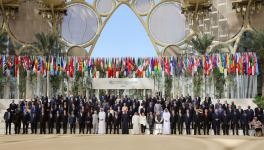The final declaration hammered out in
Cancun in the appropriately termed the Moon Palace, has trumped the urgent needs of planet Earth of cutting greenhouse gas emissions. What has emerged is that developing countries have now agreed to a common instrument for emission commitments while the developed countries – the 37 Annex I countries -- have promised nothing in return.
True,
Kyoto Protocol has not been formally buried, and the multilateral UN forum for climate change -- the
UNFCCC still continues. True, Cancun did not end as a public disaster as Copenhagen did. But the all-important second commitment period and the cuts the rich countries will take, have been left undefined. Worse, they have now been linked to the binding commitments that the developing countries will now have to take. Saving of the multilateral negotiating platform comes at these costs, borne entirely by the developing conutries. The only concession that the rich countries have made is not walking out of Kyoto.
It is now clear that the rich countries were pushing for a new agreement to replace the Kyoto Protocol’s core understanding of “common but differentiated responsibility”. In Cancun, they have achieved this -- all countries have now agreed on a common binding protocol, without differentiating their responsibility. Only 20% of the world's population belonging to a small set of rich countries have 75% of the world's stock of greenhouse gases in the atmosphere, while 80% of the rest have only 25% of the stock. Countries such as the US that emit per capita 5-6 times the global average to countries such as India which emits only half as much the global average. All are now on a common footing. This is completely inequitable and would impose huge costs on developing countries forcing them to adopt an expensive, low emission pathway, even though they have very low level of emissions.
With this, the US and the other rich countries plans to bury Kyoto, which started in Bali is now complete. Instead of a set of binding commitments that countries make based on their historical responsibility, we have a set of loose individual commitments given by all countries. Neither is the quantum of the cuts calibrated in any way to the requirement to prevent climate change. Worse, while the rich countries may propose some weak measures for emission reduction, there will be nothing to hold them to such promises. However, the developing countries will be held accountable to their promises, as they will be taking green funding. At one stroke, the binding commitments are now only for the poorer countries while the rich countries do what they will. A more perverted climate change treaty is difficult to imagine. No wonder it originated in the Moon Palace – planet earth was not obviously on the agenda.
The market driven CDM agenda continues; even the meagre cuts that the Annex I countries are propsoing will be largely through such measures. The physical cuts from countries who have the largest share in the stock of greenhouse gases today may therefore to very little in terms of actual reductions.
With this, the US position that they will come into a global Climate Change Agreement only if it is voluntary and they can make whatever pledge that will pass by their Congress, has been accepted by the rest of the world. First to fall in line, were Japan, Australia and Canada. This happened well before Copenhagen. In Copenhagen we saw EU fall in line as well. The BASIC group of countries—China, India, Brazil and South Africa -- still stood with the Group of 77; the rich countries could not steam roller this agenda in Copenhagen. But the
Copenhagen Accord – the agreement reached between the US and BASIC countries -- proved to be the thin end of the wedge. It was ambiguous enough to be regarded either as a voluntary set of cuts by developed and developing countries alike or as an interim statement pending the working out of Second Commitment period for the rich or Annex I countries. Now what has come through in Cancun is the first interpretation – Copenhagen Accord was an intermediate step from Bali to Cancun – transforming the binding cuts on high emitters to a voluntary, let-us-do-what-we-can approach for all countries. It may make the summit leaders feel good, but will do nothing to solve the climate change crisis for the world.
The Environ Minister, Jiaram Ramesh has now done what his
secret letter circulated before Copenhagen proposed. India has visibly broken ranks -- with first G77, and then also with BASIC. He agreed in the Ministerial speech at the start of Cancun that developing countries could take on legally binding commitments. He has now been party to virtually jettisoning the Kyoto Protocol. All this was done without any promise in return – while the developing countries have now made a major shift by agreeing to take on binding commitments, the rich countries have delivered nothing except for some funds. As we have seen before, giving concessions without any reciprocity does not help in climate negotiations.
Both these –
taking on binding commitments and moving away from Kyoto protocol -- crossed redlines that the Government had committed in Parliament. This is therefore not just an executive decision but a major deviation from a solemn commitment made by the Government to the Indian people in Parliament. A part of Jairam Ramesh’s mandate as given by the Cabinet gives the game away. One part of his agenda was to align climate change negotiations with our “Foreign Policy Objective”. This explains why Jairam facilitated the US agenda of converting Kyoto to its virtual opposite. With this, Jairam has also given up on equity as the basis of climate change negotiations -- that per capita carbon space must be the basis for any climate change negotiations – another commitment made before the Indian Parliament.
It is important to also note that Wikileaks has already brought out how the US and the EU has used
coercive diplomacy to force AOSIS – Association of Small Island States – to toe their line. It is not surprising that the AOSIS joined US and EU in trying to jettison Kyoto –they are after all small countries with limited resources facing big threats from global warming. Unlike the AOSIS, India it appears needed no coercive diplomacy. We have willingly climbed on to the US bandwagon. Jairam Ramesh should not be surprised that he should be getting praise abroad – read the rich countries -- and galis here. This is the choice he consciously made. Unfortunately, the poor of this country and elsewhere will have to suffer the consequences of this choice.
























